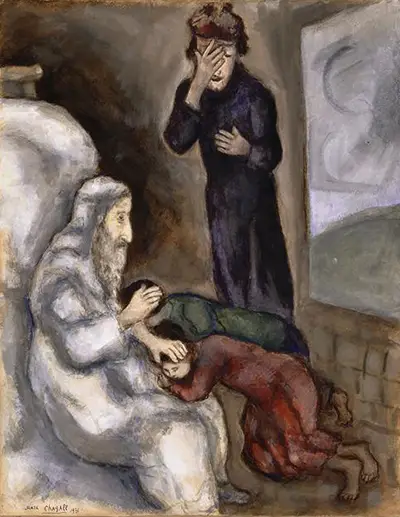It is unclear exactly when the painting was created, but it is estimated to be between 1931 and 1956. It is currently part of the European and American Prints and Drawings category. The medium of the painting is print etched on woven paper material. The painting dimensions are 44.3 x 32.7 cm when folded, and the plate is 29.2 x 23.1 cm. Its access number is 30177.26. The credit line goes to Gift of Félix Quinet, Ottawa, 1988, in memory of Joseph and Marguerite Liverant. If you want to check it out is currently located at the National Gallery of Canada, open for viewing by the public. It is open from 10:00 a.m. to 8:00 p.m. on 380 Sussex Drive, Ottawa, ON, Canada, so you can book your tickets and get an exclusive viewing of the painting.
It is clear from the painting and its name that Marc Chagall was a religious person. The painting comes directly from one of the religious stories in the Bible. It shows four different characters who, according to the Bible, may have been from the same family. The painting shows one of the characters to be an older man sitting down with two children bowing down on his lap. From the narrative, the old man wearing a white rib is Jacob is a symbol of purity and faithfulness to God from his actions. His bearded and stature would clearly indicate that he has lived for more years than the other characters in the painting.
There are two children; the one wearing a red robe is Ephraim, Joseph's youngest son, and the one wearing a green cloth is Manasseh, the oldest son. They are Ephraim and Manasseh, the sons of Jacob seen wearing a black robe and covering his eyes, a sign of frustration. From the name of the painting, the two children seem to be receiving some form of blessing from Jacob, their grandfather. The frustration that Joseph shows is due Jacob's decision when giving the blessing to the son. Instead of blessing Manasseh first since he is Joseph’s oldest son, Jacob starts by blessing Ephraim first by placing his hands first on him.
Marc Chagall's use of colors in this painting is rather intriguing. There are no bright colors and only the use of whites and greys to show the contrast between the levels of each character. The setting seems to be in a room represented by dull colors showing the social class the characters have been living in. The artist has hundreds of paintings influenced by different people throughout his life. The paintings might seem simple, but they always have a special message to pass across.
